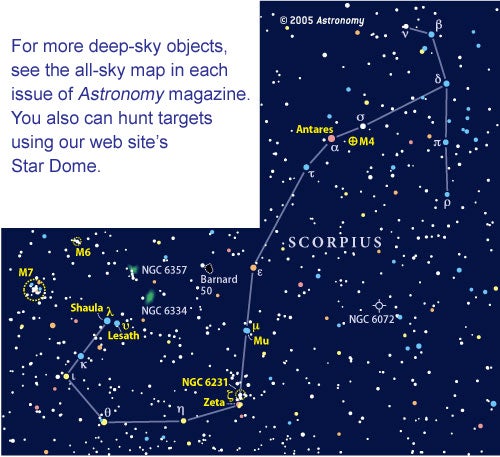The bright orange star Antares, marking the Scorpion’s heart, also attracts our attention. Even though it lies about 600 light-years away, Antares is the 15th brightest star in the night sky.
Antares puts on a grand show through binoculars, but a clear view to the south is needed to truly appreciate it. Although Antares is red, its low altitude often causes it to put on quite a colorful light show, flickering among red, orange, yellow, white, and even blue and green. This distorting effect, caused by the turbulent layers of our planet’s atmosphere, can be dazzling.
If you look carefully just to the west of Antares (to the right, if you are located north of Earth’s equator, or to the left if to the south), you should see a fuzzy smudge of light among the surrounding field of stars. That’s M4, a globular cluster containing perhaps 100,000 stars. Antares and M4 appear close in the sky by circumstance. In reality, M4 is about 12 times farther away, lying 7,200 light-years from us. Although far away, it’s one of the closest globulars.
Be sure to pause at open cluster NGC 6231, which lies just north of (above) Zeta. Some 120 searing blue and blue-white stars are crammed inside this tight cluster. They look faint through binoculars because we are seeing them from 5,900 light-years away. But if we could magically reduce that distance to that of the Pleiades cluster (380 light-years), the brightest stars in NGC 6231 would outshine Sirius in our sky.
Continue along the Scorpion’s curved body to the tip of its stinger, marked by the stars Shaula and Lesath. If you place the pair on the southern, or bottom, edge of your binoculars’ field, you should see two distinct clumps of stars to the north and northeast (above and to the left): M6 and M7, respectively.
The brightest stars in M6 seem to form a rectangle, although more inventive eyes can imagine a butterfly’s outline among the stars. Look for two wings outstretched from the butterfly’s centered body. The butterfly appears to be headed southeast.
M7 is larger and brighter than M6, and so should be more obvious. Even in the smallest binoculars, M7 will burst into a striking assortment of stars covering an area larger than the Full Moon. Several of its 80 stars show subtle hues of yellow and blue, with the brightest a yellow beacon lying close to the group’s center.
Next time out, we’ll go on a binocular tour of our galaxy’s center. Meanwhile, remember: Two eyes are better than one!










